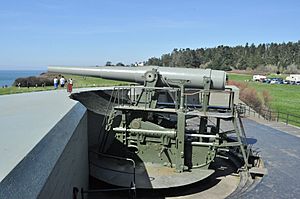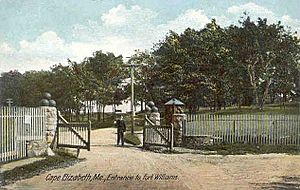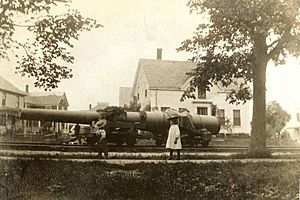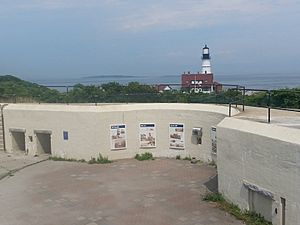Fort Williams (Maine) facts for kids
Quick facts for kids Fort Williams |
|
|---|---|
| Part of Harbor Defenses of Portland | |
| Cape Elizabeth, Maine | |

10-inch disappearing gun at Fort Casey, Washington state, similar to those at Fort Williams.
|
|
|
Location in Maine
|
|
| Coordinates | 43°37′24″N 70°12′40″W / 43.62333°N 70.21111°W |
| Type | Coastal Defense |
| Site information | |
| Owner | Town of Cape Elizabeth, Maine |
| Controlled by | Town of Cape Elizabeth |
| Open to the public |
yes |
| Site history | |
| Built | 1898 |
| Built by | United States Army |
| In use | 1898-1962 |
| Battles/wars | |
Fort Williams was an important United States Army fort in Cape Elizabeth, Maine. It was active from 1872 to 1964. This fort was part of the Harbor Defenses of Portland. Its job was to protect the port and naval anchorage in Portland from 1904 to 1950. After the fort closed, it became a beautiful public space called Fort Williams Park.
Contents
The Story of Fort Williams
Building the Fort: The Endicott Era
In 1872, the army bought 14 acres of land near Portland Head Light. This land became a small outpost for Fort Preble. On April 13, 1899, it was officially named Fort Williams. It was named after Brevet Major General Seth Williams. By 1903, the fort had grown to over 90 acres.
A group called the Board of Fortifications, also known as the Endicott Board, suggested building many new forts in 1885. Fort Williams was one of these new forts. Its guns were first tested in 1898, just before the Spanish–American War. The fort was fully finished by 1906.
When it was built, the fort had three main gun areas, called batteries. Battery Sullivan had two 10-inch guns on special disappearing carriages. Battery DeHart had three 10-inch disappearing guns. Battery Hobart had one 6-inch Armstrong gun. These were all built between 1896 and 1898.
Later, three more batteries were added. Battery Blair got two large 12-inch disappearing guns in 1903. Battery Garesché received two 6-inch disappearing guns in 1906. Battery Keyes got two 3-inch fast-firing guns in 1906. These smaller guns were used to protect a minefield in the water. You can still see where a dock for loading mine planters was near Battery Keyes. There's also an underground bunker nearby that was used for the mine system. This bunker was later used for Cold War civil defense. The fort also had powerful Searchlights. One searchlight could even "disappear" by folding down into a tower.
Between 1900 and 1911, many support buildings were built at Fort Williams. These included enlisted barracks (places for soldiers to live). There were also houses for non-commissioned officers and commissioned officers. Other buildings included a hospital, gym, and a post exchange (a store for soldiers). The fort also had a bakery, a slaughterhouse, a commissary (food store), and a laundry. There was a chapel, a fire station, and the main Fort headquarters. Garages and storage sheds were also built.
The fort had its own power station and a special underground telephone switchboard. It also had pumps and underground storage tanks for gasoline and fuel oil. For fun, soldiers had a baseball field with concrete bleachers. There were also clubs, and the officers' club used a large house called the Goddard mansion. In 1913, the 6-inch gun from Battery Hobart was moved to Hawaii.
Protecting the Coast in World War I
During World War I, many soldiers were stationed at Fort Williams. These included artillery companies from the Coast Artillery Corps and Maine National Guard troops. Anti-aircraft guns were also added to help defend against planes.
In 1917, two 10-inch guns from Battery Sullivan were removed. Both 6-inch guns from Battery Garesché were also taken away. The plan was to send them to the Western Front in France. However, only one of the 6-inch guns actually made it to France. The 10-inch guns were meant to be used as railway artillery. But this plan didn't work out, and these guns were not used in France. After the war, the 10-inch guns were returned to Fort Williams. But Battery Garesché remained without its guns.
Between the World Wars
A sign at the fort mentions that it housed 155 mm guns after World War I. These guns were mobile, meaning they could be moved around. They were based on French guns used in the war. Special round concrete platforms, called "Panama mounts," were built. These platforms allowed the guns to be used more effectively. Some of these platforms were at Fort Baldwin in Phippsburg, Maine and at Biddeford Pool.
Fort Williams in World War II and Beyond
Fort Williams was the main headquarters for the Harbor Defenses of Portland during World War II. By the middle of the war, most of the old coastal artillery guns were removed. They were too old and not useful anymore. Only Battery Keyes' two 3-inch guns remained.
In early World War II, the main army units at Fort Williams were the 8th Coast Artillery Regiment and the 240th Coast Artillery Regiment. By 1945, newer, more powerful batteries like the 16-inch Battery Steele on Peaks Island had taken over.
Fort Williams received its last guns in 1943. These were four 90 mm dual-purpose guns. They were part of Anti-Motor Torpedo Boat Battery (AMTB) 961. You can still see the places where two of these guns were, south of the lighthouse. By 1944, there was little threat from enemy ships on the East Coast. So, many coastal defenses were scaled back. In January 1950, the Coast Artillery Corps was disbanded. Fort Williams' job changed from defending the harbor to supporting all military units in Maine.
Watching the Skies: The Radar Station
From 1950 to 1951, Fort Williams had a Air Defense Command Lashup Radar Network station. It was called Site L-2. It had a TPS-1B radar. The 657th Aircraft Control and Warning Squadron operated it from January to September 1951. The radar station closed in October 1951. After that, Fort Williams became a training site for the Air National Guard. Other Air Force units also used the fort for training until April 1954.
From Fort to Park: Its Final Years
On June 30, 1962, Fort Williams officially closed. It was given to the General Services Administration to be sold. The Town of Cape Elizabeth bought the property on December 1, 1964. Over time, many of the fort's buildings were torn down. However, some structures still remain, either whole or as preserved ruins. Most of the concrete bunkers and gun areas were filled in. But Batteries Keyes, Hobart, and Garesche are still mostly intact. You can also see the outlines of all the other gun emplacements on the ground. One of the two areas of Battery Blair was recently uncovered again. Its top parts were cleaned and painted, and signs were added to explain its history. There are plans to restore the second part of Battery Blair too.
Fort Williams Park Today
After many ideas for its future, the Cape Elizabeth Town Council decided on July 23, 1979, to make Fort Williams into Fort Williams Park. The park is open to everyone for a small parking fee. It has lots of fun things to do. You can find two tennis courts, a basketball court, and a baseball field. There's also a fitness course, picnic tables, and places to cook out. The park has a picnic shelter and a children's garden. It's a great place for walking, running, and walking your dog. Everyone who visits Portland Head Light also passes through the park, making it very popular. The Beach to Beacon 10K race is one of the biggest events held at the park each year.






